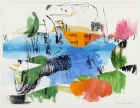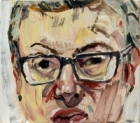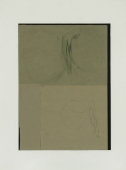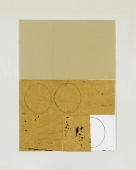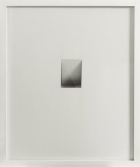
Artist | Manfred Stumpf (*1957)
https://www.artist-info.com/artist/Manfred-Stumpf
 Artist Portfolio Catalog
Artist Portfolio Catalog
| Image | Artist | Title | Year | Material | Measurement | ||||||||||||||||||||
|---|---|---|---|---|---|---|---|---|---|---|---|---|---|---|---|---|---|---|---|---|---|---|---|---|---|
 |
Manfred Stumpf | Die Attrappe | 1992 | Installation | |||||||||||||||||||||

Manfred Stumpf (*1957)Die Attrappe
|
|||||||||||||||||||||||||
 |
Manfred Stumpf | Einzug in Jerusalem (Yokohama Ve... | 1992 | Matrixdrucker auf Papier | 29,7 x 21 cm | ||||||||||||||||||||

Manfred Stumpf (*1957)Einzug in Jerusalem (Yokohama Version)
|
|||||||||||||||||||||||||
 |
Manfred Stumpf | untitled (Donkey Cycle) | 1987 | matrix dot printer paper | 29,7 x 21 cm | ||||||||||||||||||||

Manfred Stumpf (*1957)untitled (Donkey Cycle)
|
|||||||||||||||||||||||||
 |
Manfred Stumpf | untitled (Donkey Cycle) | 1987 | matrix dot printer paper | 29,7 x 21 cm | ||||||||||||||||||||

Manfred Stumpf (*1957)untitled (Donkey Cycle)
|
|||||||||||||||||||||||||
Biography
Biography
Born in 1957, Manfred Stumpf lives and works in Frankfurt / Main
geboren 1957 geboren, lebt und arbeitet in Frankfurt am Main
About the work (english / deutsch)
About the work (english / deutsch)
Drawings on the Donkey Cycle
The Museum für Moderne Kunst acquired the cycle of drawings exhibited here at the time they were produced, namely between 1990 and 1992.
The drawings were generated at the glowing monitor of a computer. Manfred Stumpf believes that, as a drawing tool und aid, the computer is the logical continuation of the precise and regular lines characteristic of his early rapidograph-based drawings. Working at a computer terminal is, to Stumpf's mind, the contemporary form of the artist-cum-monk’s spiritual exercises as a researcher. The starkly schematic presentation of the „Entry into Jerusalem“ can be seen to be the central motif of the cycle: a variation on Christian iconography, with a male figure riding a donkey and holding a palmfrond in his hands. Manfred Stumpf has been working on these „icons“ for a good decade now. In his drawings, the shape of paIm frond often switches over into that of a feather pen or oscillates between a fish skeleton und the paths taken by the main nerves in the human body.
The computer drawings an the donkey cycle should be seen in the context of a comprehensive public art project that Stumpf launched in Frankfurt in the summer of 1992, namely the mosaic an the walls of the „Habsburgerallee“ subway station on the U7 line.
There we find a cycle comprising a caravan of 66 donkeys, moving along the walls in the same direction as the subway trains at the respective platforms. The donkeys accompany the traveler on his (life’s) journey. People using this means of public transport wait for trains along with the donkeys und they are there to greet you on arrival, too.
On the journey down the tracks the beasts of burden carry not only religious pictures such as the above mentioned „icons“ or the Virgin Mary with the Infant Jesus on their flight to Egypt. Rather, they also struggle under the load of everyday objects: consumer goods, such as washing machines and supermarket trolleys, as well as means of communications such as cheque cards, telephones, cameras and TV sets. Donkeys also put in an appearance as satyrs or angels (or as Pegasus). A donkey also bears the „Ego“ and an enormous brain of his own; other objects carried include a crucifix from a passion play, medicine, a model of an atom and Marcel Duchamp’s „Bottle-Rack“. Finally, one of the donkeys’ tails takes the form of a „§“, symbolizing the Law. What we see is a media cross-over between Christian and mythological iconography and the symbols and logos of our world today, of our transport systems, our means of monetary exchange, indeed of the reproductive instinct of two donkeys. All of this is blended using computer graphics, whereby black or white square tessera corresponds to a pixel (i.e. picture element) in the computer image. Programmed pictures of the world today, or Ravenna goes to Frankfurt.
The donkeys trot along, all that lies ahead of them is a lily, a symbol of the Annunciation. The donkey is an image for the viewer / artist as traveler, as believer, as voyeur, kin the search for his or her own existence. S/he has a heavy burden to carry en route, that of „icons“ of religion, mythology, the armaments industry, the modern world of consumer commodities, drugs, sexuality and, last but not least, art, with all its obsessions and dependencies. The computer as a means of transport and as a medium. Electronic images as the icons of the 20th century.
The donkey is also just as much a means of transport as is the subway train. "The Entry into Jerusalem“ can be seen as an allegory for humankind’s journey. The city as the Jerusalem of the future?
German text by Mario Kramer / Translation by Jeremy Gaines
(Extract - Full printed version available in the Museum)
MMK - Museum für Moderne Kunst, Frankfurt am Main
Zeichnungen zum Esels-Zyklus
Die Zeichnungen entstanden am leuchtenden Bildschirm des Computers. Als Zeichenwerkzeug und Hilfsmittel stellt der Computer für Manfred Stumpf die konsequente Weiterführung seiner präzisen und gleichmäßigen Linienführung in den frühen Rapidograph-Zeichnungen dar. Die Arbeit am Computer ist für Manfred Stumpf die zeitgemäße Form der Exerzitien des Künstler-Mönches als Forscher. Als zentrales Motiv des Zyklus’ erkennen wir die stark schematisierte Darstellung des „Einzuges in Jerusalem“, in Abwandlung der christlichen lkonographie, als eine auf einem Esel reitende, männliche Figur, die einen Palmzweig in den Händen hält. Manfred Stumpf arbeitet seit nunmehr zehn Jahren an dieser “lkone“. Im zeichnerischen Werk des Künstlers wechselt die Gestalt des Palmzweiges oft vom Federkiel oder von der Fischgräte zu menschlichen Nervenbahnen.
Die Computer-Zeichnungen zum Esels-Zyklus sind im Zusammenhang eines umfangreichen Projektes für den öffentlichen Raum zu sehen, das hier in Frankfurt im Sommer 1992 entstand: das Wandmosaik der U-Bahnhaltestelle „Habsburgerallee“ (Linie U 7).
Hier begegnet uns als Zyklus eine Karawane von 66 Eseln, die ihre Bewegungsrichtung in der jeweiligen Fahrtrichtung der U-Bahn-Züge aufnehmen. Die Esel begleiten den Fahrgast auf seiner (Lebens-)Reise. Der Benutzer dieses öffentlichen Nahverkehrsweges verbringt mit ihnen seine Wartezeit und sie empfangen ihn bei seiner Ankunft.
Auf dieser Reise entlang des Schienenstrangs befördern die Packesel nicht nur religiöse Bilder wie die bereits erwähnte „lkone“ oder Maria mit dem Jesukind auf der Flucht nach Ägypten, sondern auch Alltagsgegenstände und Konsumgüter wie Waschmaschine und Einkaufswagen oder Kommunikationsmittel wie Scheckkarte, Telephon, Fotoapparat und Fernseher. Der Esel tritt auch als Satyr und als Engel (oder Pegasus) in Erscheinung. Er schleppt das „Ich“ und das eigene riesige Gehirn, das Kreuz als Passionswerkzeug, ein Medikament, ein Atommodell und den „Flaschentrockner“ von Marcel Duchamp. Schließlich formt sich sein Eselsschwanz zum Paragraphen. Eine mediale Verknüpfung von christlich/mythologischer lkonographie mit den Symbolen und Signets unserer heutigen Umwelt, der öffentlichen Verkehrswege, des Geldverkehrs bis hin zum Fortpflanzungstrieb zweier Esel. Dies alles verschmilzt mit den Mitteln der Computergraphik, wobei das einzelne Pixel (Abk.: picture element) des Computerbildes den quadratischen schwarzen und weißen Mosaiksteinen entspricht. Programmierte Bilder unserer Zeit. - Ravenna im Frankfurt von heute.
Die Esel trotten in einem fort, im Visier einzig eine Lilie - ein Symbol für die Verkündigung. Der Esel ist ein Bild für den Betrachter / Künstler als Reisender, als Gläubiger, als Voyeur auf der Suche nach der eigenen Existenz. Er hat schwer zu schleppen an den „lkonen“ Religion, Mythos, Aufrüstung, Konsum moderner Warenwelt, Drogen, Sexualität und nicht zuletzt Kunst in all ihren Obsessionen und Abhängigkeiten. Der Computer ist Transportmittel und Medium. Elektronische Bilder “waren die 'lkonen’ des 20. Jahrhunderts“.
Der Esel als Reittier ist ebenso ein Vehikel wie der U-Bahn-Zug. „Der Einzug in Jerusalem“ ist gleichnishaft auf die Reise des Menschen zu übertragen. Die Großstadt als zukünftiges Jerusalem?
Text von Mario Kramer
(Auszug - Der vollständige Text ist als Informationsblatt beim Museum erhältlich)
MMK - Museum für Moderne Kunst, Frankfurt am Main
 Exhibition Announcements Exhibition Announcements 
| Learn more about this service |
|---|
 offers / Requests offers / Requests  |
Learn more about this service |
|---|
 Visualization |
Learn more about this service | ||
|---|---|---|---|

Interested in discovering more of this artist's networks?
3 easy steps: Register, buy a package for a visualization, select the artist.
See examples how visualization looks like for an artist, a curator, or an exhibition place: Gallery, museum, non-profit place, or collector.

Exhibition History

|
SUMMARY based on artist-info records. More details and Visualizing Art Networks on demand. Venue types: Gallery / Museum / Non-Profit / Collector |
||||||||||||
| Exhibitions in artist-info | 61 (S 21/ G 40) |
Did show together with - Top 5 of 677 artists (no. of shows) - all shows - Top 100
|
||||||||||
| Exhibitions by type | 61: 30 / 13 / 17 / 1 | |||||||||||
| Venues by type | 33: 12 / 5 / 15 / 1 | |||||||||||
| Curators | 9 | |||||||||||
| artist-info records | May 1983 - Nov 2016 | |||||||||||
|
Countries - Top 5 of 6 Germany (40) Netherlands (4) Switzerland (3) United States (2) Italy (1) |
Cities - Top 5 of 17 Frankfurt am Main (37) Nürnberg (3) Basel (3) Amsterdam (3) Darmstadt (2) |
Venues (no. of shows )
Top 5 of 33
|
||||||||||
Curators (no. of shows)
Top 5 of 9
|
| Galerie Martina Detterer | G | Oct 2016 - Nov 2016 | Frankfurt am Main | (149) | +0 | |
| Dommuseum Frankfurt am Main | S | May 2015 - Aug 2015 | Frankfurt am Main | (2) | +0 | |
| Galerie Martina Detterer | S | May 2014 - Jul 2014 | Frankfurt am Main | (149) | +0 | |
| Galerie Martina Detterer | G | Dec 2013 - Feb 2014 | Frankfurt am Main | (149) | +0 | |
| Galerie Martina Detterer | G | May 2013 - Jul 2013 | Frankfurt am Main | (149) | +0 | |
| Weiermair, Peter (Curator) | +0 | |||||
| Galerie La Brique | S | Sep 2012 - Dec 2012 | Frankfurt am Main | (14) | +0 | |













